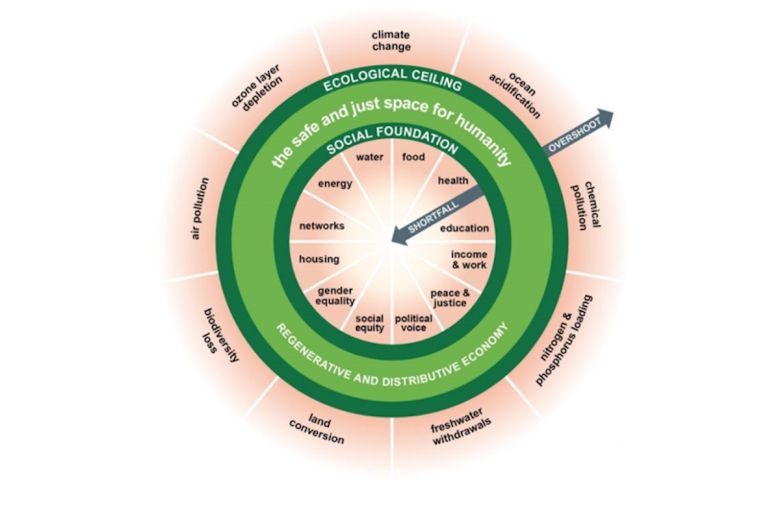Top Stories
Critique of Doughnut Economics: A Review of Raworth’s Ideas

Kate Raworth’s book, *Doughnut Economics: Seven Ways to Think Like a 21st-Century Economist*, has stirred significant discussion since its release in March 2017. The book aims to challenge traditional economic paradigms, proposing a new framework that attempts to balance human prosperity with environmental sustainability. While the “Doughnut” concept captures an essential tradeoff between these two areas, a deeper examination reveals several fundamental issues with Raworth’s approach.
The history of modern economics presents a backdrop to Raworth’s work. In the 1960s and 1970s, a mathematical approach to economics gained prominence. Influential figures like Paul Samuelson and Ken Arrow established models that depicted the economy as a series of rational agents engaging in market transactions. Although these economists did not advocate for libertarian ideals, their models were later appropriated by conservative economists to promote free-market principles.
As the intellectual dominance of this mathematical framework coincided with the rise of neoliberal policies, many critics began to question the narrative surrounding free markets. They typically fell into two categories: those who sought to reform economic models from within the established academic framework and those who rejected the mainstream entirely in favor of alternative perspectives from fields such as ecology and sociology. This latter group, often labeled as “heterodox” economists, struggled to establish a cohesive alternative to the prevailing economic narrative.
In response to these critiques, Raworth’s *Doughnut Economics* attempts to provide a new vision. Central to her argument is the “Doughnut” diagram, which illustrates the balance between human prosperity and environmental sustainability. The inner circle represents the minimum threshold for human dignity, while the outer circle signifies the ecological limits of the planet. According to Raworth, staying within this “safe and just space for humanity” is crucial for sustainable development.
While the Doughnut provides a visually appealing representation of complex interactions between human welfare and environmental health, it has significant limitations. The production possibilities frontier (PPF) already serves as a well-established tool to depict similar tradeoffs in economics. The PPF can effectively illustrate the relationship between production and environmental sustainability, providing a clear analytical framework often used in introductory economic courses. Yet, Raworth dismisses this model in favor of her Doughnut, seeking to revolutionize economic thinking rather than evolve the existing models.
Raworth’s critique of traditional growth models resonates with the growing discourse around degrowth, especially in regions such as the United Kingdom and Northern Europe. While acknowledging the importance of economic growth for developing nations, she also emphasizes the dangers of infinite growth in wealthy countries. This duality positions her work at the intersection of economic development and environmental responsibility.
Despite her insightful observations, Raworth’s arguments sometimes overlook the complexities of economic growth and social progress. While she critiques GDP as an inadequate measure of human flourishing, many alternative metrics, including the Human Development Index, remain closely correlated with GDP. This correlation suggests that economic growth continues to play a crucial role in alleviating poverty.
Furthermore, Raworth’s dismissal of traditional economic models may undermine her credibility. For instance, she suggests that economics should transition from a predictive tool to a normative discipline focused on societal goals. This shift risks neglecting the practical applications of economic theory, such as demand forecasting and resource allocation, which are essential for effective governance and planning.
In her eagerness to dismantle the existing economic framework, Raworth occasionally misinterprets mainstream concepts. For example, she conflates quantitative easing with low-interest-rate policies, demonstrating a misunderstanding of how these mechanisms function. Additionally, her proposal for “People’s QE” lacks clarity on potential inflationary consequences and overlooks historical precedents that illustrate the complexities of monetary policy.
Despite these critiques, Raworth’s work is not without merit. Many of her observations about the inadequacies of mainstream economics are valid, particularly regarding environmental issues and income inequality. However, the book often feels more like a polemic than a rigorous academic analysis, overwhelming the reader with numerous critiques without providing a coherent alternative.
Ultimately, *Doughnut Economics* highlights the ongoing struggle within the field of economics to reconcile traditional theories with the pressing challenges of the 21st century. While Raworth’s call for a new economic paradigm is compelling, her inability to synthesize these ideas into a cohesive framework leaves her argument vulnerable. The book serves as a reminder that the quest for a more equitable and sustainable economic model remains an open and evolving debate.
-

 Business5 months ago
Business5 months agoKenvue Dismisses CEO Thibaut Mongon as Strategic Review Advances
-

 Lifestyle4 months ago
Lifestyle4 months agoHumanism Camp Engages 250 Youths in Summer Fest 2025
-

 Sports4 months ago
Sports4 months agoDe Minaur Triumphs at Washington Open After Thrilling Comeback
-

 Sports5 months ago
Sports5 months agoTupou and Daugunu Join First Nations Squad for Lions Clash
-

 Top Stories5 months ago
Top Stories5 months agoColombian Senator Miguel Uribe Shows Signs of Recovery After Attack
-

 World5 months ago
World5 months agoASEAN Gears Up for Historic Joint Meeting of Foreign and Economic Ministers
-

 Health4 months ago
Health4 months agoNew Study Challenges Assumptions About Aging and Inflammation
-

 Business5 months ago
Business5 months agoOil Prices Surge Following New EU Sanctions on Russia
-

 Entertainment4 months ago
Entertainment4 months agoDetaşe-Sabah Violin Ensemble Captivates at Gabala Music Festival
-

 Entertainment4 months ago
Entertainment4 months agoBaku Metro Extends Hours for Justin Timberlake Concert
-

 Top Stories5 months ago
Top Stories5 months agoRethinking Singapore’s F&B Regulations Amid Business Closures
-

 Business5 months ago
Business5 months agoU.S. House Approves Stablecoin Bill, Sends to Trump for Signature









